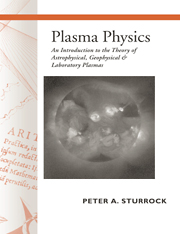Book contents
- Frontmatter
- Contents
- Preface
- 1 Introduction
- 2 Basic concepts
- 3 Orbit theory – uniform fields
- 4 Adiabatic invariants
- 5 Orbit theory
- 6 Electromagnetic waves in a cold electron plasma
- 7 Electromagnetic waves in an electron-ion plasma
- 8 Two-stream instability
- 9 Electrostatic oscillations in a plasma of nonzero temperature
- 10 Collision theory
- 11 MHD equations
- 12 Magnetohydrodynamics
- 13 Force-free magnetic-field configurations
- 14 Waves in MHD systems
- 15 Magnetohydrodynamic stability
- 16 Variation principle for MHD systems
- 17 Resistive instabilities
- 18 Stochastic processes
- 19 Interaction of particles and waves
- Appendix A Units and constants
- Appendix B Group velocity
- Appendix C Amplifying and evanescent waves, convective and absolute instability
- References
- Author index
- Subject index
1 - Introduction
Published online by Cambridge University Press: 05 June 2012
- Frontmatter
- Contents
- Preface
- 1 Introduction
- 2 Basic concepts
- 3 Orbit theory – uniform fields
- 4 Adiabatic invariants
- 5 Orbit theory
- 6 Electromagnetic waves in a cold electron plasma
- 7 Electromagnetic waves in an electron-ion plasma
- 8 Two-stream instability
- 9 Electrostatic oscillations in a plasma of nonzero temperature
- 10 Collision theory
- 11 MHD equations
- 12 Magnetohydrodynamics
- 13 Force-free magnetic-field configurations
- 14 Waves in MHD systems
- 15 Magnetohydrodynamic stability
- 16 Variation principle for MHD systems
- 17 Resistive instabilities
- 18 Stochastic processes
- 19 Interaction of particles and waves
- Appendix A Units and constants
- Appendix B Group velocity
- Appendix C Amplifying and evanescent waves, convective and absolute instability
- References
- Author index
- Subject index
Summary
The plasma state is sometimes referred to as the ‘fourth’ state of matter. As a solid is heated, it first goes through a transition in which bonds between adjacent molecules are loosened but not entirely broken, and the matter moves into the liquid state. As the matter is heated further, bonds holding adjacent particles close together are completely broken so that molecules can move more or less independently and the liquid becomes a gas. Further heating will lead to the dissociation of molecules into their constituent atoms. However, further heating may also lead to the ionization of the molecules or atoms of the gas, so that the gas then comprises neutral particles, ions and electrons. Although there is no sharp phase transition between the state of a simple neutral gas and the plasma state, the plasma state may nevertheless be regarded as part of the sequence solid-liquid-gas-plasma.
Since the plasma state includes free positive and negative charges, and since movements of these charges produce electrical currents, it is clear that the constituents of the plasma state will be influenced by electric and magnetic fields, and that the plasma can also produce electric and magnetic fields. Hence, in discussing the properties of a plasma, it is essential to regard the electromagnetic field as an integral part of the plasma system. This fact leads to a rich – indeed bewildering – array of properties of the plasma state.
- Type
- Chapter
- Information
- Plasma PhysicsAn Introduction to the Theory of Astrophysical, Geophysical and Laboratory Plasmas, pp. 1 - 5Publisher: Cambridge University PressPrint publication year: 1994
- 1
- Cited by

